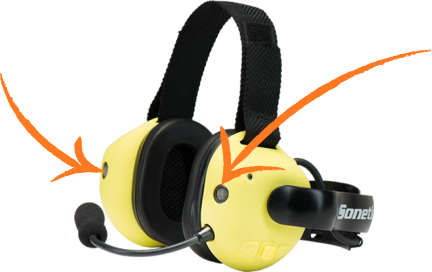If you’ve ever worked in a challenging, high-noise environment, then you know about the catch-22 between protecting your hearing and being able to hear your surroundings and coworkers. Do you wear earmuffs or earplugs? Or do you risk noise exposure so you don’t feel isolated and vulnerable?
The most popular choice is to do both. Wear hearing protection while using a tool or machine, and take it off when you finish or when you don’t feel safe. Not optimal. Not productive. Plus you’re exposed to other dangerous and unanticipated noises. And you probably have earmuffs or corded plugs hanging from your neck, restricting movement and in danger of getting caught on something.
Technology-based situational awareness
With hearing protection, the more comfortable the solution the more likely you are to use it. But comfort means more than just how the headset fits over your ears or with your hardhat. It also includes how wearing the headset makes you feel. Sonetics developed stereo listen-through technology to give you control over how much of the noise in your surrounding environment you need to hear to stay safe. The key: With listen-through technology, you don’t have to remove your hearing protection to hear those sounds.
How it works
Listen-through microphones let users hear their environment without removing their hearing protection.
Stereo microphones – Every Sonetics wireless headset has a microphone on the forward edge of each ear dome. When you toggle the listen-through feature on, those microphones let you hear outside sound without the need to remove the headset and its vital hearing protection. The stereo separation created by those microphones helps you perceive whether a sound is coming from in front, from behind or to the side.
Dial in your perfect mix – You’ll hear outside sounds at the same time you hear voice communication happening over the wireless headset. It’s important to note that team members on wireless comms with you will only hear your voice, not your listen-through audio.
The independent listen-through volume control means you’ll always be able to hear voice communication. And you can choose between four volume levels for just the right amount in any situation. Turned up to maximum, listen-through actually amplifies your normal hearing slightly, giving you what we call “wolf ears.”
Protection from impulse sound – But how can you protect your hearing with all this extra sound and awareness? Any sudden loud sounds you hear while listen-through is on are automatically limited to 82 decibels to ensure compliance with hearing safety and conservation standards. If you’ve ever used shooter’s muffs at the range, this feature works in a very similar way.
See how simple it is to use stereo listen-through push-button controls in this video.
Optimal use cases for stereo listen-through
tThough stereo listen-through exists to make wireless headsets comfortable for the entirety of every shift, there are some use cases where improved situational awareness is absolutely essential. With stereo listen-through, workers can wear a headset to protect hearing, maintain situational awareness and improve their ability to hear warning shouts because other workers in the crew can just talk to them in a normal voice over the headset.
Here are a few places where workers only feel comfortable with their head on a swivel:
- Working in a trench: Workers in a trench may not feel comfortable wearing hearing protection because they already feel vulnerable and don’t want to block out any machine noise or warning shouts.
- Road construction and maintenance: Civilian traffic may be coming in four or more directions. Work site traffic comes from everywhere. Earth movers sound different than diesel vans. While they’re both loud, workers want to protect hearing while being able to hear which type of vehicle is approaching from behind.
- Crane work: For crane operators, the cab is noisy but requires the ability to hear alarms. For spotters, the ability to communicate with the operator is integral, but so is the need to avoid pinch points and other machinery.
- Plant floor: Working around finely tuned machinery requires coordination and the ability to hear if a machine is out of tune. Many manufacturing workers operate in tight quarters, too, so it’s important to be able to hear what’s happening outside the work area, or beyond line of sight (PA announcements, whistles, shutdown alarms, approaching forklifts, etc.).
- Towing: Tow truck drivers operate in some of the busiest, most dangerous conditions imaginable. With traffic speeding by, tow crews have to rig dangerously unstable vehicles. They need to be able to listen for traffic and audio indicators that their equipment is functioning properly while coordinating with the public, emergency personnel and other members of their team.
- Water rescues: There are no roads on a waterway. When traffic comes from anywhere, boat operators are compromised during a boarding or rescue. They have to be able to hear other watercraft in the vicinity or a change in water conditions that may put them in danger.
Perhaps the most empowering aspect of stereo listen-through is that you can turn it off. Sometimes isolation can be pleasant, but only when you decide it’s safe.






